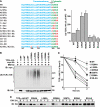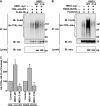Serine residues in the cytosolic tail of the T-cell antigen receptor alpha-chain mediate ubiquitination and endoplasmic reticulum-associated degradation of the unassembled protein
- PMID: 20519503
- PMCID: PMC2911338
- DOI: 10.1074/jbc.M110.127936
Serine residues in the cytosolic tail of the T-cell antigen receptor alpha-chain mediate ubiquitination and endoplasmic reticulum-associated degradation of the unassembled protein
Abstract
The T-cell antigen receptor (TCR) alpha-chain (TCRalpha) is a type I integral membrane protein that becomes ubiquitinated and targeted to the endoplasmic reticulum (ER)-associated degradation (ERAD) pathway when it fails to assemble into the heteromeric TCR complex. Remarkably, TCRalpha has a cytosolic tail of only five amino acid residues (i.e. RLWSS), none of which is the conventional ubiquitin acceptor, lysine. Herein we report that substitution of two conserved serine residues in the cytosolic tail of TCRalpha to alanine decreased ubiquitination, whereas placement of additional serine residues enhanced it. Moreover, replacement of the cytosolic serine residues by other ubiquitinatable residues (i.e. cysteine, threonine, or lysine) allowed ubiquitination to take place. Serine-dependent ubiquitination perfectly correlated with targeting of TCRalpha for ERAD. We also found that this ubiquitination was mediated by the ER-localized ubiquitin ligase, HRD1. These findings indicate that serine-dependent, HRD1-mediated ubiquitination targets TCRalpha to the ERAD pathway.
Figures








Similar articles
-
MHC class I molecules are preferentially ubiquitinated on endoplasmic reticulum luminal residues during HRD1 ubiquitin E3 ligase-mediated dislocation.Proc Natl Acad Sci U S A. 2013 Aug 27;110(35):14290-5. doi: 10.1073/pnas.1303380110. Epub 2013 Aug 8. Proc Natl Acad Sci U S A. 2013. PMID: 23929775 Free PMC article.
-
A Novel Peptide-Based SILAC Method to Identify the Posttranslational Modifications Provides Evidence for Unconventional Ubiquitination in the ER-Associated Degradation Pathway.Int J Proteomics. 2013;2013:857918. doi: 10.1155/2013/857918. Epub 2013 Feb 3. Int J Proteomics. 2013. PMID: 23431445 Free PMC article.
-
Role of intramembrane charged residues in the quality control of unassembled T-cell receptor alpha-chains at the endoplasmic reticulum.J Cell Sci. 2010 Apr 1;123(Pt 7):1031-8. doi: 10.1242/jcs.059758. J Cell Sci. 2010. PMID: 20332119 Free PMC article.
-
Lectin-like ERAD players in ER and cytosol.Biochim Biophys Acta. 2010 Feb;1800(2):172-80. doi: 10.1016/j.bbagen.2009.07.029. Epub 2009 Aug 6. Biochim Biophys Acta. 2010. PMID: 19665047 Review.
-
[Physiological Roles of Ubiquitin Ligases Related to the Endoplasmic Reticulum].Yakugaku Zasshi. 2016;136(6):805-9. doi: 10.1248/yakushi.15-00292-2. Yakugaku Zasshi. 2016. PMID: 27252059 Review. Japanese.
Cited by
-
The evolving role of ubiquitin modification in endoplasmic reticulum-associated degradation.Biochem J. 2017 Feb 15;474(4):445-469. doi: 10.1042/BCJ20160582. Biochem J. 2017. PMID: 28159894 Free PMC article. Review.
-
gp78 functions downstream of Hrd1 to promote degradation of misfolded proteins of the endoplasmic reticulum.Mol Biol Cell. 2015 Dec 1;26(24):4438-50. doi: 10.1091/mbc.E15-06-0354. Epub 2015 Sep 30. Mol Biol Cell. 2015. PMID: 26424800 Free PMC article.
-
KLHL12 Promotes Non-Lysine Ubiquitination of the Dopamine Receptors D4.2 and D4.4, but Not of the ADHD-Associated D4.7 Variant.PLoS One. 2015 Dec 30;10(12):e0145654. doi: 10.1371/journal.pone.0145654. eCollection 2015. PLoS One. 2015. PMID: 26717573 Free PMC article.
-
ERAD of proteins containing aberrant transmembrane domains requires ubiquitylation of cytoplasmic lysine residues.J Cell Sci. 2015 Nov 15;128(22):4112-25. doi: 10.1242/jcs.171215. Epub 2015 Oct 7. J Cell Sci. 2015. PMID: 26446255 Free PMC article.
-
Hepatitis B Core Protein Is Post-Translationally Modified through K29-Linked Ubiquitination.Cells. 2020 Nov 26;9(12):2547. doi: 10.3390/cells9122547. Cells. 2020. PMID: 33256078 Free PMC article.
References
Publication types
MeSH terms
Substances
Grants and funding
LinkOut - more resources
Full Text Sources

